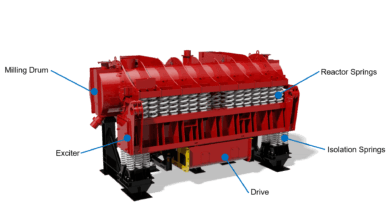A vibratory mill is a machine used for grinding materials. These machines are a critical component for mining and mineral industries, but not all machines are made equal. New technology is advancing the vibratory mill’s capabilities, improving outputs and production for several factories and mines.
How a vibratory mill works
Grinding can be done in batches, or in a continuous flow process (which is more common). First, material enters one end of a vibratory grinding mill drum into horizontal cylinders. Then, the mill uses a vibratory motion to mix and grind the particles, with operating speeds ranging from 800 to 1500 rpm. Typical vibratory mills use attrition and low energy impacts to grind materials properly.
The material migrates through grinding media as the drum vibrates. It then flows out through a perforated plate and is discharged for screening. If necessary, the material can be recirculated and added back to the drum to run through the cycle again.
What are the pros and cons of vibratory grinders?
Vibratory mills are one of several technologies available in the vibratory grinding market, and there are many benefits to this process.
- Pro: Grinders are flexible and can operate in either wet or dry grinding processes. However, an enclosed chamber that helps contain the dust will function best with dry grinding.
- Pro: Another benefit of a vibratory mill’s construction is its lift-and-throw motion — highly abrasive material doesn’t wear on liners and media as quickly. This also means your end product has less contamination.
- Pro: Vibratory drums are great for fine grinding, commonly down to 50% passing 15 microns.
On the other hand, vibratory drums do have some limitations.
- Con: Capacity and infeed particle size must be taken into consideration.
- Con: Vibratory drums have difficulty grinding flexible, fibrous or sticky material.
What makes General Kinematics’ vibratory mills unique?
The design of vibratory mills manufactured by General Kinematics has evolved to keep up with market trends and developing needs in the industry. Features like sub-resonant design and double barrel drums increase efficiency and decrease costs.
Thanks to a combination of a smaller drive force and better-distributed loads, our sub-resonant mill consumes less power and has improved structural reliability. This also allows for increased capacity with a larger drum design. Drums as large as 6’ x 18’ are currently available, but we’re continuously working to increase that size even more.
Our double barrel grinding drum also improves operating efficiency and production. Rather than increasing the machine size to increase capacity, the double barrel drum boosts grinding energy by doubling the available spring locations. Instead of using ballast weights on the inactive side of the barrels, a set of springs makes use of the space to increase the grinding rate and energy of the barrels. If this makes you nervous, all of our equipment can be monitored 24/7 by utilizing Vertex™ to ensure safety and minimize downtime!
Constant improvements in grinding and attrition
Grinding operations are critical processes in many industries. As existing operations evolve along with an industry’s needs, manufacturers must work hard to improve vibratory grinding technology to keep up. The technologies on our existing vibratory mills can significantly increase safety and efficiency while decreasing downtime and total cost of ownership. Browse the GK site to learn more about our grinding and attrition solutions, or reach out to General Kinematics to talk about your mining needs with an experienced team member.







